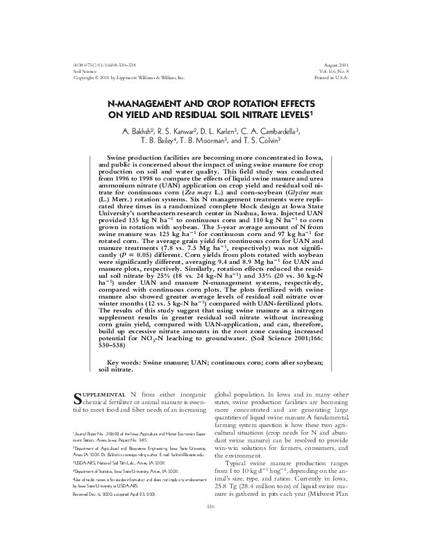
Swine production facilities are becoming more concentrated in Iowa, and public is concerned about the impact of using swine manure for crop production on soil and water quality. This field study was conducted from 1996 to 1998 to compare the effects of liquid swine manure and urea ammonium nitrate (UAN) application on crop yield and residual soil nitrate for continuous corn (Zea mays L.) and corn-soybean (Glycine max (L.) Merr.) rotation systems. Six N management treatments were replicated three times in a randomized complete block design at Iowa State University's northeastern research center in Nashua, Iowa. Injected UAN provided 135 kg N ha-1 to continuous corn and 110 kg N ha-1 to corn grown in rotation with soybean. The 3-year average amount of N from swine manure was 123 kg ha-1 for continuous corn and 97 kg ha-1 for rotated corn. The average grain yield for continuous corn for UAN and manure treatments (7.8 vs. 7.5 Mg ha-1, respectively) was not significantly (P = 0.05) different. Corn yields from plots rotated with soybean were significantly different, averaging 9.4 and 8.9 Mg ha-1 for UAN and manure plots, respectively. Similarly, rotation effects reduced the residual soil nitrate by 25% (18 vs. 24 kg-N ha-1) and 33% (20 vs. 30 kg-N ha-1) under UAN and manure N-management systems, respectively, compared with continuous corn plots. The plots fertilized with swine manure also showed greater average levels of residual soil nitrate over winter months (12 vs. 5 kg-N ha-1) compared with UAN-fertilized plots. The results of this study suggest that using swine manure as a nitrogen supplement results in greater residual soil nitrate without increasing corn grain yield, compared with UAN-application, and can, therefore, build up excessive nitrate amounts in the root zone causing increased potential for NO3-N leaching to groundwater.
Available at: http://works.bepress.com/douglas_karlen/69/

This article is from Soil Science 166 (2001): 530–538.